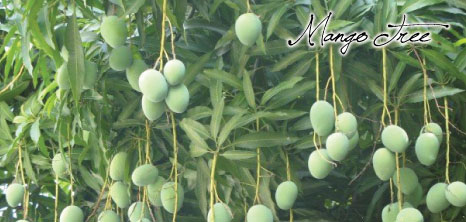|
Mango TreeThe mango tree (Mangifera indica) is quite a crucial fruit in its native land India and that cruciality has grown and very much extended to Barbados. Writings from its native land India, show that the mango tree is one of the oldest cultivated trees with records dating back more than 4,000 years.
In Barbados, the most popular types of mango are 'Julie' and 'Pawi' (Père Louis). The usual fruiting season for the mango tree is in the summer months but it is also possible for this season to go into the month of December.
DescriptionThe mango tree is a beautiful, large tropical tree that grows on the island of Barbados and produces a fruit that is enjoyed by Barbadians of all ages. The mango tree is self-fruiting with large stalks of small flowers, which don't always mature into full fruit. The ovate fruits of the mango tree grow at the end of stringlike stems with waxy and smooth surfaces. When ripe, mangoes are usually bright yellow to orange in colour.
The flesh of the mango is peachlike, very juicy and eaten directly off the seed or cut into pieces depending on the individual's preference. When new growth appears on the tree, it is rather pretty with a colour of light green to dark red to purple leaves.
Mangoes on the island of Barbados are truly a delicacy as children can be seen throwing pebbles or the very fruit at them just to ensure their share of mangoes in the summer time. A favourite in Barbados is eating mangoes while in the sea to give them that semi-salty taste.
Medicinal Properties of the MangoMangoes are not just sweet and juicy to taste, they are also filled with many health benefits.
Mangoes are often eaten fresh off the tree but can also be used in preserves, desserts and as a flavoring for many foods. The skin is not normally eaten, however, children on the island of Barbados find it quite delightful to eat. Green mangoes are used to make mango chutney.
DISCLAIMER: The information provided on this page should not be interpreted as personal medical advice or instruction. No action should be taken based solely on the contents of this site.
Readers should consult the appropriate health professionals on any matter relating to their health and well being.
The information and opinions provided here are believed to be accurate and sound, based on the best information available to the writers. However, readers who fail to consult the appropriate health authorities automatically assume risk of any injuries. Barbados Pocket Guide is not in any way responsible for errors or omissions.
|
|
|


